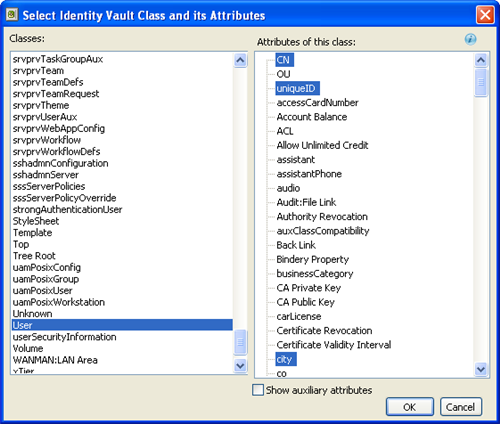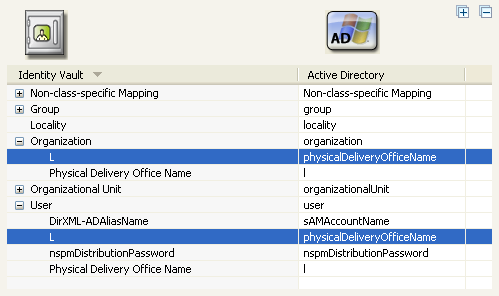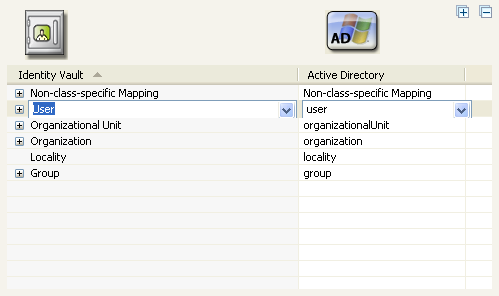6.2 Editing a Schema Map Policy
The Schema Map editor allows you to create and edit schema map policies. This section includes the following topics:
For information about exporting and importing a schema map policy, see Section 6.4, Exporting and Importing with the Schema Map Editor.
6.2.1 Adding or Deleting Classes and Attributes
There are three types of classes or attributes you can add to a schema map. The process for adding each type of class or attribute varies.
When you add or remove a class or attribute in the Schema Map policy, Designer updates relevant filters at the same time. For more information about filters, see Section 7.0, Controlling the Flow of Objects with the Filter.
Adding an Identity Vault Class or Attribute
You can both add new Identity Vault classes and attributes to a schema map, and add additional Identity Vault attributes to an existing class mapping.
To add a new Identity Vault class and attributes to a schema map:
-
In the Schema Map Editor, select
 .
.
You can also right-click in the Schema Map editor, then click .
-
In the Select Identity Vault Class and its Attributes page, select a class and the relevant class attributes to add to the schema map, then click .
Use Shift+click and Ctrl+click to select multiple attributes, if desired.

-
In the Schema Map Editor, double-click each class and attribute you added to the schema map, then specify the appropriate Application class (or attribute) to which you want to map it.
You can either select the class or attribute name from the drop-down list, or type it in the field manually.

-
To save the schema map changes, select > .
To add additional Identity Vault attributes to an existing class mapping:
-
In the Schema Map Editor, select a class mapping, then select
 .
.
You can also right-click in the Schema Map editor, then select .
-
In the Select ID Vault Attributes page, select the desired attributes to add to the class mapping, then click .
Use Shift+click and Ctrl+click to select multiple attributes, if desired.
-
In the Schema Map Editor, double-click each attribute you added to the schema map, then specify the appropriate Application attribute to which you want to map it.
You can either select the attribute from the drop-down list, or type it in the field manually.

-
To save the schema map changes, select > .
Adding an Application Class or Attribute
You can both add new Application classes and attributes to a schema map, and add additional Application attributes to an existing class mapping.
IMPORTANT:To view an application’s schema classes and attributes, the driver must be able to retrieve the schema information from a live application environment. This occurs automatically when a driver starts (right-click the driver, then select > ). However, you can refresh the application schema at any time by selecting ![]() .
.
To add a new Attribute class and attributes to a schema map:
-
In the Schema Map Editor, select
 .
.
You can also right-click in the Schema Map editor, then click .
-
In the Select Application Class and its Attributes page, select a class and the relevant class attributes to add to the schema map, then click .
Use Shift+click and Ctrl+click to select multiple attributes, if desired.
-
In the Schema Map Editor, double-click each class and attribute you added to the schema map, then specify the appropriate Application class (or attribute) to which you want to map it.
You can either select the class or attribute name from the drop-down list, or type it in the field manually.

-
To save the schema map changes, select > .
To add additional Application attributes to an existing class mapping:
-
In the Schema Map Editor, select a class mapping, then select
 .
.
You can also right-click in the Schema Map editor, then select .
-
In the Select App Attributes page, select the desired attributes to add to the class mapping, then click .
Use Shift+click and Ctrl+click to select multiple attributes, if desired.
-
In the Schema Map Editor, double-click each attribute you added to the schema map, then specify the appropriate Identity Vault attribute to which you want to map it.
You can either select the attribute from the drop-down list, or type it in the field manually.

-
To save the schema map changes, select > .
Adding a Non-class-specific Attribute Mapping
Sometimes an attribute mapping doesn’t apply to a specific class. In this case you can define the attribute mapping in the Non-class-specific container.
To add a non-class-specific attribute mapping:
-
Select the entry in the Schema Map Editor.
-
Add the appropriate attribute mapping using one of the methods described previously.
For more information, see Adding an Identity Vault Class or Attribute and Adding an Application Class or Attribute.
Deleting a Class or Attribute Mapping
If you do not want an Identity Vault class or an attribute to be mapped to an Application class or attribute, the best practice is to completely remove the class or the attribute from the Schema Map policy. To remove multiple classes or attributes at the same time, use Ctrl-click or Shift-click to select more than one class or attribute at a time.

You can add or remove attributes and classes from the Schema Map policy in the following ways:
-
Select the classes or attributes you want to remove, then right-click and select .
-
Select the classes or attributes you want to remove, then click
 in the Schema Map editor toolbar.
in the Schema Map editor toolbar.
-
Select the classes or attributes you want to remove, then press the Delete key.
You can also delete all classes and attributes at once by selecting ![]() .
.
6.2.2 Refreshing the Application Schema
If you have modified the schema in the application, these changes need to be reflected in the Schema Map policy. To make the new schema available, click the toolbar pull-down menu, then select ![]() .
.
Refreshing the application schema requires a connection to the live application because the application driver must be able to query the application for the updated schema.
6.2.3 Editing Items
To edit a mapping, double-click the selected row. An in-place editor appears, allowing you to edit the mapping.
Figure 6-2 In-line Edits in the Schema Map Editor

6.2.4 Sorting Schema Map Entries
The Schema Map editor allows you to sort entries in ascending/descending order by clicking on the column heading. Click the Identity Vault heading to sort entries based on Identity Vault items. Click the connected system heading to sort entries based on connected system items.
6.2.5 Managing the Schema
Designer allows you to manage the Identity Vault schema and any connected system's schema. You can import the schema, modify it, and deploy the changed schema back into the Identity Vault or the Application.
To manage the Identity Vault schema, click the pull-down menu ![]() , then select
, then select ![]() . This opens the Manage Schema tool and displays information about the classes and attributes in the Identity Vault schema.
. This opens the Manage Schema tool and displays information about the classes and attributes in the Identity Vault schema.
To manage the Application schema, click the pull-down menu ![]() , then select
, then select ![]() . This opens the Manage Schema tool and displays information about the classes and attributes in the Application schema.
. This opens the Manage Schema tool and displays information about the classes and attributes in the Application schema.
For more information about how to manage the schema, see Managing the Schema
in the Designer 3.0.1 for Identity Manager 3.6 Administration Guide.